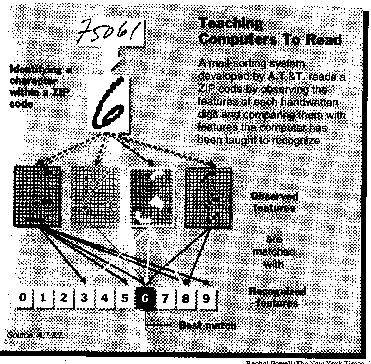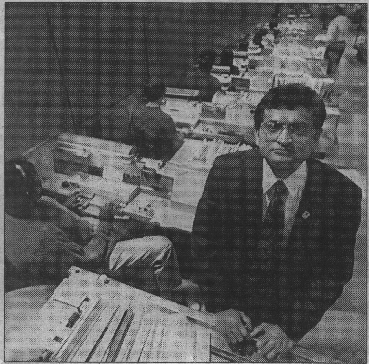

Wednesday, May 27, 1992
Page D1 and D7

In the future envisioned by the United States Postal Service neither bloom of night nor a citizen scrapped scribble will stay on envelope from its appointed rounds.
A dozen companies are competing for a Postal Service contract to harness sophisticated optical-scanning technology and computer-based artificial intelligence to one of the post office's most tedious and costly tasks: deciphering handwritten addresses.

"Our focus has been in showing competence, rather than speed," said
Sargur Srihari, director of the Center of Excellence for Document
Analysis and Recognition, a Postal Service research laboratory at
the State University of New York at Buffalo.
Each day the nation's postal system already the most automated on the globe and becoming increasingly so, handles some 555 million pieces of mail-- 40 percent of the world's total. At many big post offices, scanning equipment can read most typewritten or machine-printed envelopes. The equipment is even sophisticated enough in most cases to spot the address amid the typographical banner on a piece of junk mail, knowing to read "222 West 43d Street," say while ignoring "You may already be a winner."
Stumped by Scribbles
But except for the few pieces of mail hand-addressed by people with a teacher's-pet compulsion to form perfect block letters, today's machines are stumped by street names, numbers and ZIP codes rendered in pencil or pen. Such mail accounts for as much as 20 percent of daily volume.
By 1995, though the Postal Service wants its machinery to be capable of decrypting at least half of all hand-written addresses. "Instead of hoping people write their addresses," said Timothy Barnum, director of the Postal Service's office of advanced technology in Washington. In other words, postal researchers are analyzing thousands of handwriting and printing styles, looking for quirks and commonalities that computers can be taught to identify and interpret.
Researchers have already demonstrated experimental systems that can discern enough information from a handwritten envelope to meet the needs of automated letter-sorting equipment. But these test models can take up to a second or more to read an address, and the Postal Service is looking for equipment that can read 13 pieces of mail a second, the standard speed for current automated sorting machines.
"Our focus has been in showing competence, rather than speed," said Sargur Srihari, director of the Center of Excellence for Document Analysis and Recognition, a Postal Service research laboratory at the State University of New York at Buffalo.
Developing Algorithms
Besides getting machines to recognize individual letters and numbers, much of Dr. Srihari's work involves devising algorithms, or mathematical rules, for helping a computer place the characters in context.
Given a handwritten envelope for an address in Atlanta, for example, the machine may have trouble making out whether the first digit in the ZIP code 30348 is in fact a 3 or 8. It may, however, be able to see that the first letter in the preceding word is a "G" and understand that the word just before the ZIP code designates the state. The algorithm, which makes use of a data base of addresses from around the nation, knows that the state beginning with "G" has no ZIP codes beginning with 8.
"The work we are doing is indeed work in artificial intelligence," Dr. Srihari said.
The Postal Service plans to award its first round of contracts for the address-recognition project in the next six weeks or so, reducing the dozen bidders to four companies. Each company will work up detailed system proposals, making whatever use they wish of Dr. Srihari's research. Next year, the companies will be winnowed again, with perhaps a pair selected to build working models of address-recognition systems.
"The Postal Service wants to be able to use fairly inexpensive hardware," said Dr. Srihari, whose own models are based on a Sun Microsystems work station. "They don't want to spend millions of dollars on supercomputers."
The goal for the current project is a scanning and computing system that will be able to recognize enough of an address to place a bar code on the envelope. This bar code would represent the nine digits of the Postal Service's expanded "ZIP-plus-four" ZIP code plus the last two numbers of the street address.
Sorting with great Precision
With such bar codes, which the post office has already begun printing onto more and more of the nation's letters, machines can sort mail with extreme precision. Eventually, the men and women who deliver mail door to door will need only to pick up a stack of bar-coded mail from the sorting machines and place it in their letter bags, ready to be delivered in sequence as they walk or drive their routes.
Some of the nation's most sophisticated information-technology and government-contracting corporations are vying for the address-recognition contract, including AT&T., I.B.M., Litton Industries, TRW and Westinghouse. Another contender is the AEG Corporation of Germany. Largely through American licensees, AEG accounts for about three-fourths of the automated scanning and sorting equipment currently used by the Postal Service.
At stake for the contractors is much more than the post office's business. Handwriting recognition could have many commercial uses--in banking, the credit-card industry or any other business in which mounds of handwritten documents create bottlenecks for computers.
Reading Difficulty
"The whole market is moving into this digital conversion scenario," said Tim Bajarin, an analyst at Creative Strategies, a high-tech consulting firm in Santa Clara, Calif. "Being able to read and understand tons of handwritten mail -- once you show that you can work that recognition magic, you've really shown the world something."
Even in the emerging era of pen-based notebook computers reading a few words and numbers on an envelop poses great difficulties for a computer. Pen-based computers dispense with keyboards and let a user enter information by writing with an electronic stylus.
But pen-based computers have an advantage over postal scanners: they are "watching" as the person writes, so they know the sequence of the strokes, the places where the writer lifted the stylus between the words, and countless other subtle clues to recognizing the written characters.
"It's a lot easier to recognize somebody's scribble of B-I-G if you know the order of the strokes," said Gregory K. Myers, a program manager for one of the other address-recognition bidders, SRI International, a Menlo Park, Calif., research and consulting firm that previously did work for the Postal Service. "If you have only an image on a piece of paper, you have less information to start with. The interpretation is more difficult."
Another crucial difference is speed. Mr. Myers said. With a pen-based computer the writer is producing only a few characters a second. A postal handwriting- recognition system at 13 pieces of mail a second, may need to sift through 1,000 characters a second.
Bar Codes for All Mail
To the dismay of the American Postal Workers Union, the Postal Service has eliminated jobs as it has automated--cutting more than 40,000 slots since the late 1980's. That still leaves 745,000 employees. But there are plans to cut at least 50,000 more jobs by 1995, when the Postal Service intends for every piece of mail to bear a bar code, whether placed there by man or machine.